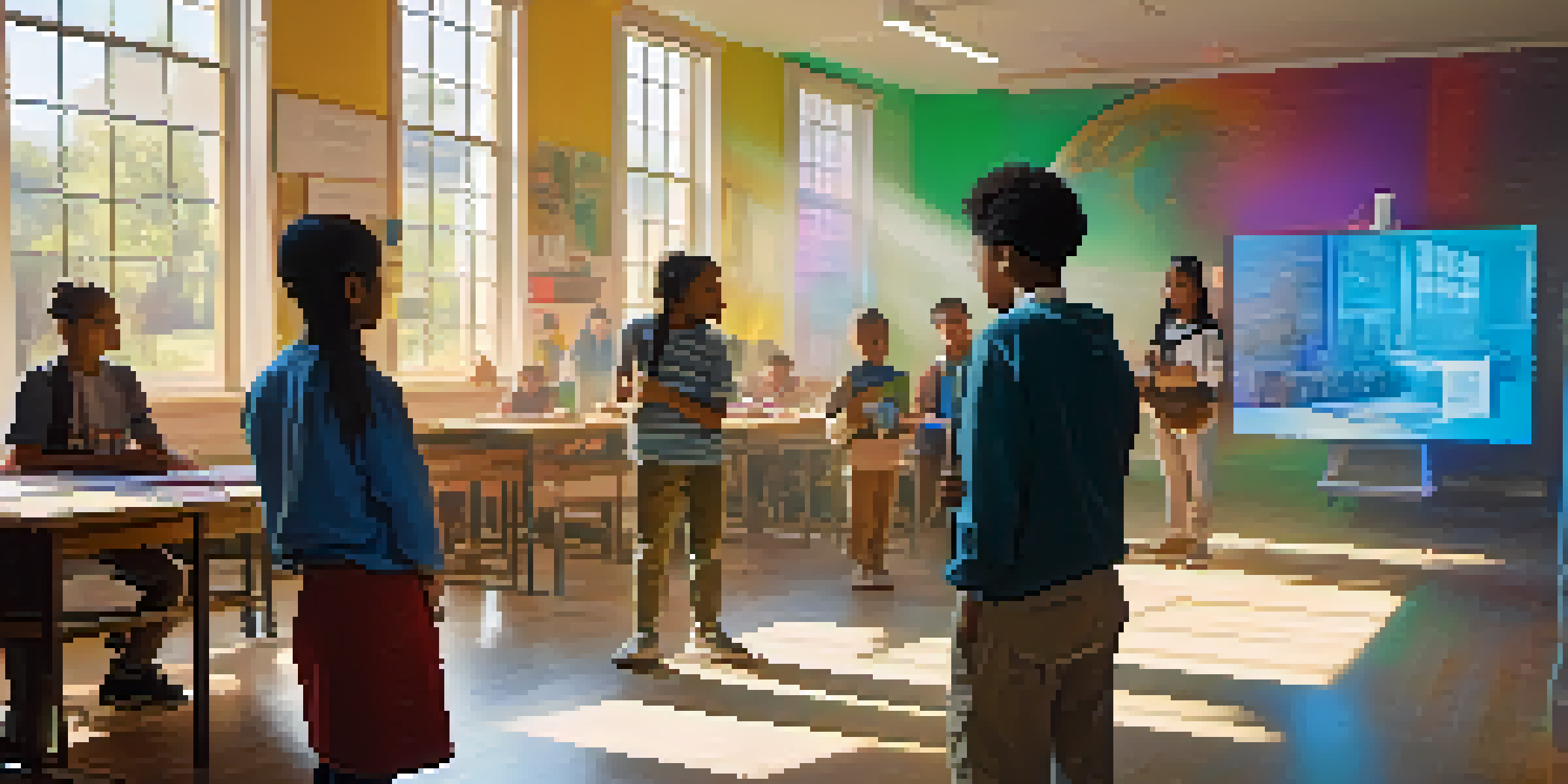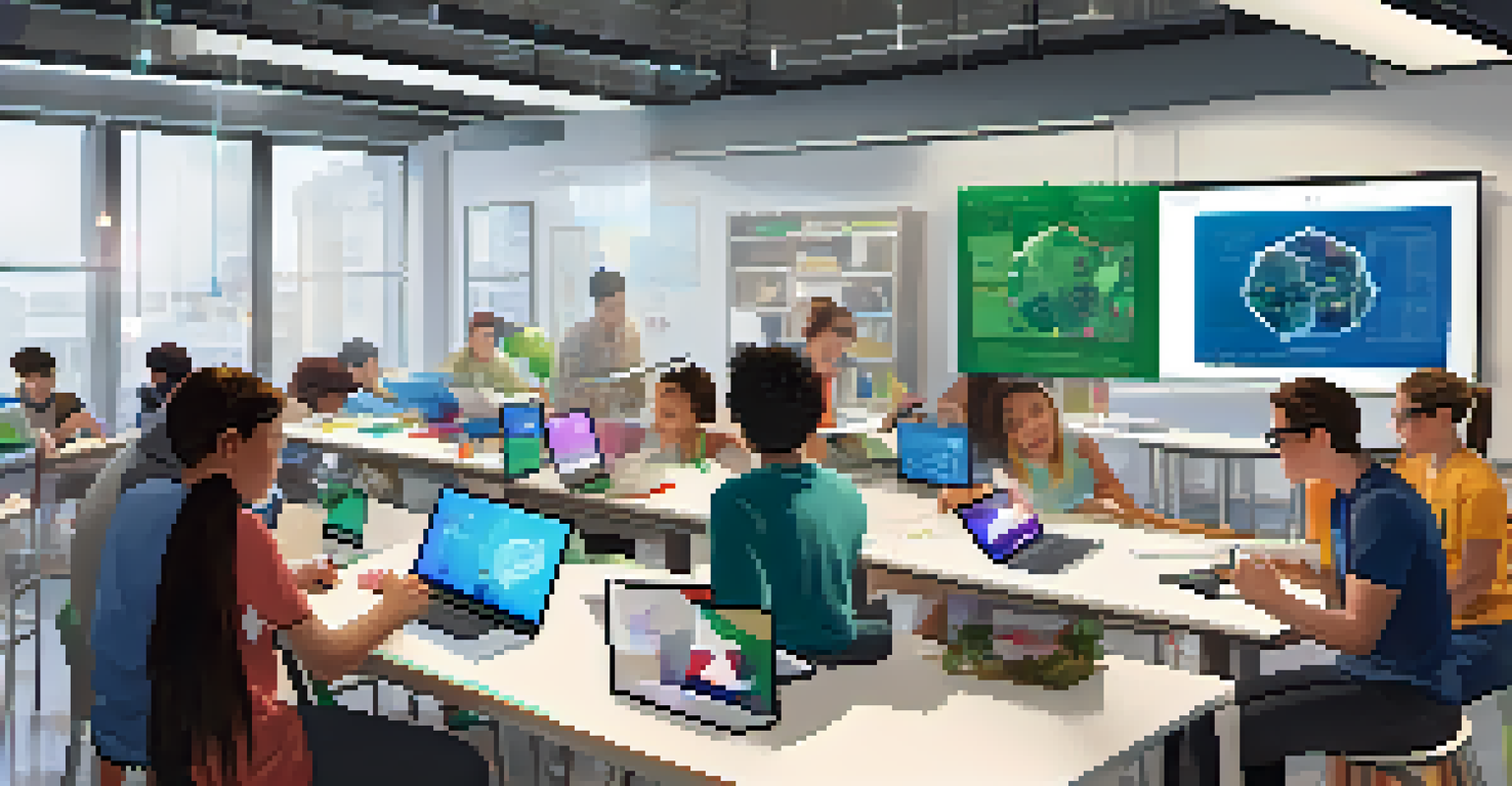Utilizing Augmented Reality in Online Learning Experiences

Understanding Augmented Reality in Education
Augmented reality (AR) merges the real world with digital elements, creating an interactive experience that enhances learning. Imagine pointing your device at a textbook and watching 3D models pop up, making complex concepts tangible. This blend of reality and technology isn’t just a novelty; it's a powerful tool that can transform how students engage with content.
Augmented reality will transform how we teach and learn, making education more immersive and engaging.
In the realm of education, AR allows learners to visualize and interact with information in ways that traditional methods simply can't match. For instance, a history lesson might come to life as students explore a virtual reconstruction of ancient Rome. This hands-on approach makes learning memorable and encourages deeper understanding.
As AR technology continues to evolve, its applications in online learning are becoming increasingly diverse. It’s not just about flashy presentations; it's about creating meaningful interactions that promote retention and enthusiasm. Educators and students alike are beginning to see the potential of AR as a game-changer in the digital classroom.
Enhancing Engagement with AR Tools
One of the most significant benefits of augmented reality is its ability to boost student engagement. Traditional online learning can sometimes feel isolating, but AR tools create a more immersive experience that captures attention. When students can actively participate in their learning, they are more likely to stay motivated and invested in the material.

For example, apps like Google Expeditions allow students to take virtual field trips, exploring everything from the depths of the ocean to outer space without leaving their homes. This not only makes learning fun but also fosters curiosity and exploration, essential components of a successful educational experience. Students are no longer passive recipients of information; they become active explorers.
AR Enhances Student Engagement
Augmented reality transforms traditional learning by creating immersive experiences that actively engage students.
Additionally, AR can cater to various learning styles, whether visual, auditory, or kinesthetic. By providing multiple ways to engage with content, AR ensures that every student can find a method that resonates with them. This personalized approach can lead to improved learning outcomes and a deeper appreciation for the subject matter.
Bridging the Gap Between Theory and Practice
AR offers a unique opportunity to bridge the gap between theoretical knowledge and practical application. In fields like medicine or engineering, students can benefit from simulations that allow them to practice skills in a safe environment. For instance, medical students can use AR to visualize anatomy and even perform virtual surgeries, gaining confidence before working with real patients.
The future of education is not just about technology, but how we use it to create meaningful learning experiences.
By providing a hands-on approach, AR helps reinforce theoretical concepts and makes them more relatable. When students can see the real-world applications of what they’re learning, their understanding deepens. This connection between theory and practice is crucial in preparing students for their future careers.
Moreover, incorporating AR into online learning can help demystify complex subjects. When students can visualize abstract concepts, they are better equipped to grasp intricate details. This practical experience not only enhances comprehension but also prepares students for real-world challenges.
Collaboration and Social Learning with AR
Augmented reality also fosters collaboration among students, even in an online setting. With AR tools, learners can work together on projects, share experiences, and solve problems collectively. This social aspect of learning is vital, as it encourages teamwork and communication skills, which are essential in today's interconnected world.
Imagine a group of students collaborating on a science project where they can visualize data in real-time using AR. They can discuss findings, share insights, and refine their understanding through interaction. This dynamic learning environment not only enhances knowledge but also builds community among learners.
Bridging Theory and Practice
AR provides practical applications for theoretical concepts, allowing students to visualize and practice skills in a safe environment.
Furthermore, AR can facilitate peer-to-peer learning, allowing students to teach and learn from each other. This collaborative approach empowers students to take ownership of their learning journey while fostering a sense of belonging. The ability to connect with peers through shared AR experiences can significantly enhance the overall educational experience.
Challenges of Implementing AR in Online Learning
While augmented reality offers numerous benefits, there are challenges to consider when integrating it into online learning. One of the primary concerns is accessibility; not all students may have the necessary devices or internet connectivity to fully engage with AR content. This digital divide can lead to disparities in learning experiences and outcomes.
Moreover, creating high-quality AR content can be resource-intensive and may require specialized skills. Not every educator has the technical expertise to develop or implement AR experiences effectively. This can create barriers for those who want to leverage AR but lack the resources or knowledge to do so.
Additionally, there’s a learning curve associated with using AR tools, both for educators and students. Training and support are essential to ensure that everyone can utilize the technology effectively. Without proper guidance, the potential of AR in enhancing online learning may go unrealized.
Future Trends in AR for Online Learning
The future of augmented reality in online learning looks promising, with advancements in technology paving the way for more innovative applications. As AR becomes more mainstream, we can expect to see a surge in user-friendly platforms that make it easier for educators to create and implement AR experiences. This democratization of technology will likely lead to richer learning environments.
Moreover, the integration of artificial intelligence (AI) with AR could enhance personalized learning even further. AI can analyze individual learning patterns and adapt AR content to meet specific needs, making education more tailored and effective. This fusion of technologies holds the potential to revolutionize how students interact with information.
Collaboration in Online Learning
AR fosters collaboration among students, enabling them to work together on projects and enhance their learning experience.
Finally, as educators continue to explore the possibilities of AR, collaborations between tech companies and educational institutions are likely to increase. These partnerships can drive innovation, ensuring that AR remains relevant and beneficial for learners. The ongoing evolution of AR in online education promises to create more engaging, accessible, and effective learning experiences.
Conclusion: The Impact of AR on Learning
In conclusion, utilizing augmented reality in online learning experiences presents a wealth of opportunities for enhancing engagement and understanding. By bridging the gap between the theoretical and the practical, AR empowers students to take an active role in their education. The collaborative nature of AR also fosters a sense of community, which is crucial in the digital learning landscape.
While there are challenges to overcome, the potential benefits far outweigh the hurdles. As technology advances and becomes more accessible, we can expect to see AR becoming an integral part of online education. This transformation has the potential to create richer, more interactive learning experiences that prepare students for the challenges of the future.

Ultimately, the impact of augmented reality on learning is just beginning to unfold. By embracing this technology, educators can inspire a new generation of learners, equipping them with the skills and knowledge necessary to thrive in an ever-evolving world.